Australian native grasses are fantastic low-maintenance additions to the garden that can add a wealth of textural interest and native beauty to your outdoor spaces.
Whether you live in the suburbs or on the urban fringe, there are many Australian native grass species to choose from ranging in height, size and colour so you’re bound to find a few perfect additions for your specific landscaping needs.
While the fad of using our native grasses has declined over the years, many devoted gardeners, including myself, know all about the excellent benefits Australian native grasses can bring to yards, hence our strong appreciation for these gorgeous plants.
More...

Some of the larger species feature perky plumes of foliage that add wonderful movement to the garden as the wind blows while others may sport variegated leaves or foliage that can add lovely colour to your outdoor spaces with the seasons.
If you’re looking to bring some native beauty and charm to your garden, ornamental Australian native grasses are easy picks. Today I will be sharing my top 24 Australian native grasses for landscaping with you in hopes that you can find a few worthwhile additions to your home’s landscape. Let’s get started.
Benefits of Australian Native Grasses
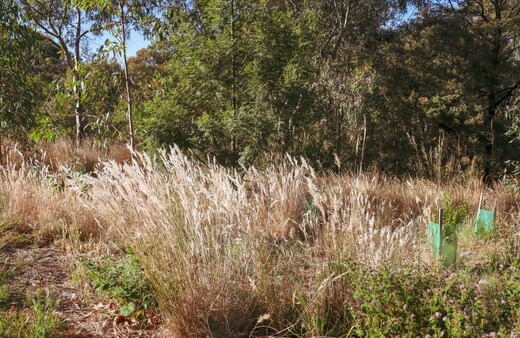
- They require less maintenance.
- They don’t need as much water and fertiliser as introduced plants.
- They generally require less pruning.
- They will attract and support native wildlife.
- They will attract beneficial bugs to your garden that can help prevent pests that destroy gardens and veggie patches.
- They help to reduce soil erosion.
- They are hardier to pests and diseases.
- They are usually more drought and frost tolerant than introduced plants.
- They establish themselves quickly and are easier to work with in the garden.
- They add textural interest to yards.
- They are perfect for trickier spots.
Landscaping Applications Using Australian Native Grasses
- Edging and bordering
- Rockery plantings
- Gap filling
- Mass planting
- Understory planting
- Lawn alternatives
Australian Native Grasses List
1. Weeping Rice Grass – Microlaena stipoides
Weeping rice grass is a hardy, low-growing native grass that can make for a great lawn, especially in cool and semi-shaded spots. It is a very water-wise species that features slender lime-green leaves and slender stems with seeds.
It is slow-growing but once established this grass impresses easily in gardens. To grow as a lawn, plant close together with a spacing of about 10 cm.
2. Bottlebrush Grass – Enneapogon nigricans
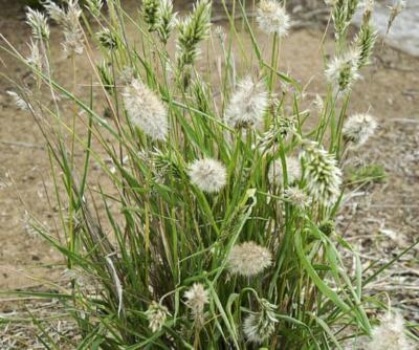
Source: keys.lucidcentral.org
Also known as shuttlecock grass, octopus grass or bottle washers, this Australian native grass grows to around 30cm tall and it can survive drought but not frost.
The seeds of this species are unique as no introduced species produce seeds that look like these. It features shapely flower heads that will look fantastic in many locations in the garden.
3. Tassel Cord Rush – Baloskion tetraphyllum
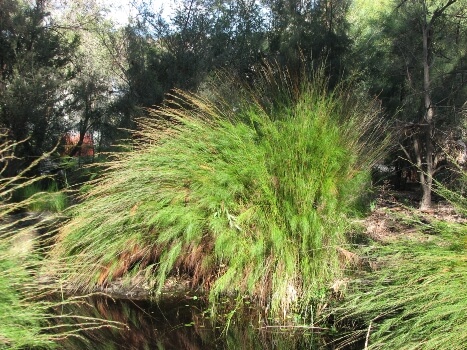
Source: Wikipedia
Boasting bright green foliage with charming feathered tips, this species is one of the more ornamental Australian native grasses. It will grow in dense clumps to a height of around 1.5 metres, offering many landscaping applications.
The foliage can turn reddish brown in spring and the flowering heads are produced in summer. This grass will thrive in shady spots in moist soil. Once established, it will require very little maintenance. Prune back every 3 years or so to ensure tidiness.


Get Your Free Guide:
Master Growing Australian Natives eBook
A Must Have Complete Guide for Every Australian Garden
Get Your Free Guide:
Master Growing Australian Natives eBook
A Must Have Complete Guide for Every Australian Garden
4. Foxtail Grass – Alopecurus
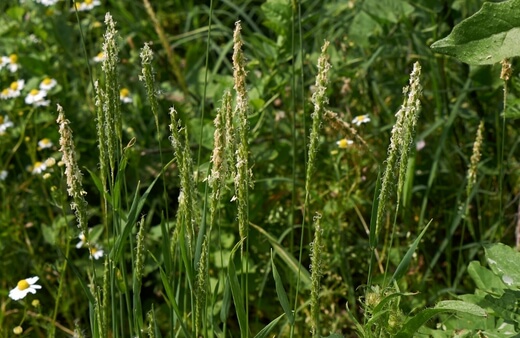
This genus of grasses offers both tall and short varieties that can come in an array of colours and forms. Most varieties feature prolific foxtail-like plumes atop fine, green foliage that reaches up to 80cm. However, some can grow as tall as 1.5 metres.
With so many stunning species to choose from here, you’re bound to find the perfect pick for your gardening needs.
5. Blue Fescue Grass – Festuca glauca
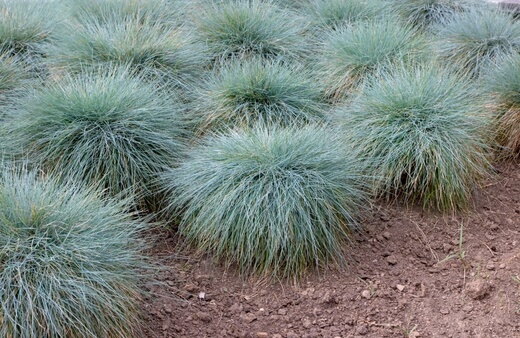
Forming dense but neat clumps of blue-grey foliage with feathery flowers, this species also offers great drought resistance and will cope with light frosts. Growing up to 20 to 25 centimetres, this native grass is perfect for coastal regions with salty air and it will also look gorgeous in rockeries.
Plant in full sun for the best results and keep tidy by pruning lightly as needed.
6. Fountain Grass – Pennisetum alopecuroides

Fountain grass will usually grow to around 90 cm tall and wide but there are also a few dwarf and taller varieties available as well. The foliage forms in emerald green mounded clumps that turn to a golden yellow in autumn with feathery flower spikes.
Perfect for filling out tough spots in the garden, this species is another drought-tolerant and very low-maintenance option. This native grass can be grown in poorer soils but it does prefer dry soil with good drainage and full sun to partial shade.
Be sure to check out our in-depth guide to growing purple fountain grass, variety of fountain grass we truely enjoy having in our garden.
7. Spreading Flax Lily – Dianella revoluta

A very common Dianella that is famed for its purple-blue flowers and brightly coloured berries, Dianella revoluta also features strappy green foliage that makes for excellent mass planting as a border or gap filler.
It grows with an attractive upright form and this particular species is also notorious for its edible berries, making it a fantastic bush tucker for our bush food enthusiasts. It will thrive in full sun to part shade and will typically reach 1 metre tall and 1.5 metres wide in cultivation.
8. Coastal Tussock Grass – Poa poiformis

Source: Plants for Spaces
Sporting gently arching, blueish-green foliage that grows to around 45 cm in height and spread, this native grass is also very tolerant to salt and wind, making it a great pick for coastal gardens.
The unique foliage will contrast beautifully with other surrounding plants when used in mass plantings and its maintenance needs are minimal once established.
Plant in full sun to partial shade for the best growth. Can be used to prevent soil erosion on exposed sites.
9. Windmill Grass – Chloris truncata
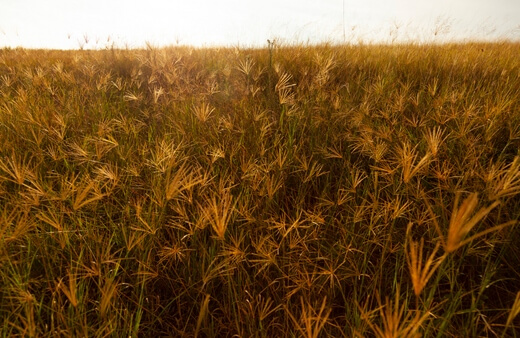
As its name suggests, this Australian native grass features flowers that look similar to a mini windmill. Coupled with its 15cm tussocks, this species usually reaches around 40 cm in height.
This grass makes for an excellent lawn alternative in low-traffic spots in the garden and it is also a good pick for those who live in drier areas. Plant in full sun to light shade using well-draining, moist soil.
10. Pennisetum alopecuroides ‘Pennstripe’
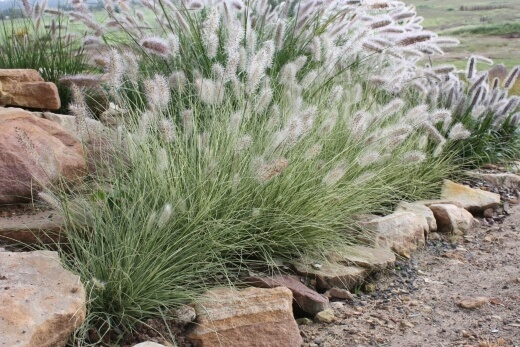
Source: Gardening With Angus
This species of Pennisetum is especially striking as it grows in a form perfect for garden landscaping. It produces soft tufts that reach around 50cm tall and wide with narrow, arching, and variegated foliage.
Furthermore, it sports lovely feathery foxtail-like plumes that can add some native texture to your outdoor spaces. This grass will look its best when grouped together and it will tolerate most soil types and exposure within gardens.
11. Stout Bamboo Grass – Austrostipa ramosissima
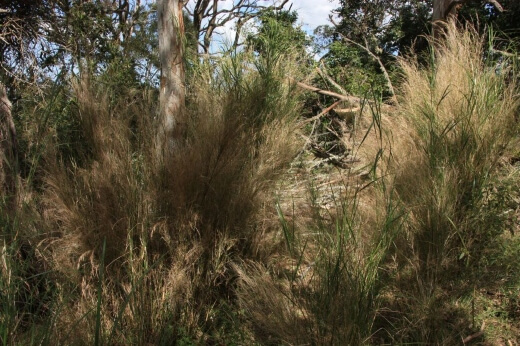
Source: VicFlora
A fantastic taller growing species among the Australian native grasses, reaching a height of about 2.5 metres. Featuring luscious green foliage, often with white horizontal stripes, this grass also produces feathery seed heads much like its counterparts.
This species prefers sunny to lightly shaded positions planted in dry well-draining soil. As it grows from underground rhizomes, it can be cut back hard if needed.
12. Kangaroo Grass – Themeda triandra

A famed and beloved native ornamental grass, Kangaroo grass produces long stems and seed pods with a strong tussock habit. It usually grows to 1.5 metres tall and half a metre wide.
The foliage starts grey-green and brightens to an orangey-brown in the summer. Perfect for mass plantings, this species is drought tolerant and a great grass for attracting native butterflies, birds and insects to the garden.
13. Poa poiformis ‘Kingsdale’

Source: Alpine Nurseries
A wonderfully clump-forming species of native grass, this plant features attractive fine, dark-green strappy leaves that gently arch at the top. Its texture is soft and luscious with the ability to add lovely colour to any garden design.
It is ideal for mass plantings or used as borders. Poa Kingsdale can grow in full sun to full shade and it will tolerate windy positions as well. Free-draining clay soils are recommended.
14. Brush Wiregrass – Aristida behriana

Source: iNaturalist
This species produces attractive green foliage with purple tips in an upright habit. As the flowers mature, they will become cream-coloured and eventually resemble a bottlebrush.
Brush wiregrass reaches about 20cm tall with flowers that reach out a little higher than that. It will also flower throughout most of the year. This plant is very tolerant to drought and also tolerant to light grazing from animals. Full sun and moist soils are preferred.
15. White Top Grass – Rytidosperma caespitosum

Source: Yarra Ranges Council
This native grass offers a very distinctive appearance for those interested in more unusual forms of grass. It produces creamy-white flower heads that look similar to a ballerina in a tutu.
This species is highly tolerant to both drought and frost and there are about 17 different species to choose from in the genus so you’re bound to find one that will suit your garden and landscaping needs.
Plant in light soil that retains good moisture. Full sun to partial shade is recommended.
16. Dianella tasmanica ‘Tasred’
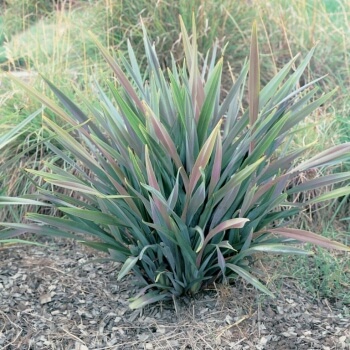
Source: Flower Power
One of the favourite Dianellas for Aussie gardens, this gorgeous cultivar is hardy, adaptable and reliable when cultivated in suburban gardens. It forms with a neat and compact habit, producing lovely wide green leaves and large purple berries.
Foliage will usually start red towards the bottom and mature into a soft green. Perfect for mass planting, this species will reach around 60cm tall and wide. Full sun to full shade is possible and sandy or loamy soils are preferred.
17. Dianella caerulea ‘Cassa Blue’
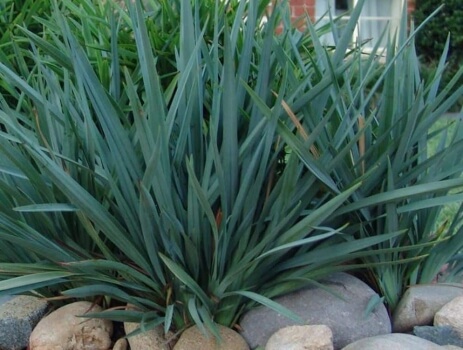
Source: Diaco's Garden Nursery
Another excellent Dianella cultivar for gardeners looking for the best Australian native grasses. This plant naturally features striking blue-green foliage with a fantastic upright habit.
With one of the longest flowering periods in its genus, this grass produces purple and yellow flowers from spring to autumn. Its compact size and shape make it suitable for any application and garden setting but it will look its best in mass plantings or as a feature.
Growth is about 50 cm tall and 40cm wide. Part shade in well-draining soil is ideal.
18. Dianella caerulea ‘Breeze’
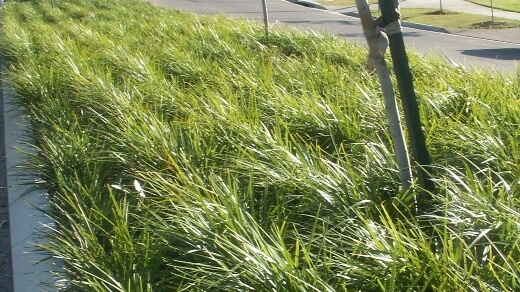
Source: Alpine Nurseries
This Dianella cultivar is a great pick for those who want a tidier native grass that spreads easily. Its strappy foliage is lime-green with a wonderful clumping habit. Being quick to establish, this plant is great for filling out beds or planting in rockeries or as an understory.
In summer, you can enjoy delicate blue and yellow flowers atop the luscious foliage. This Dianella usually reaches around 70cm tall and wide and it will tolerate humidity, cold and drought quite well. Full sun in moist soil is recommended for this cultivar.
Check out our in-depth guide for more Dianella caerulea cultivars.
19. Poa labillardieri ‘Eskdale’

Source: Ian Barker Gardens
This Australian native grass has very soft and fine slender leaves with a willowing yet upright habit. The foliage is grey-green, contrasting beautifully with the more vivid surrounding vegetation.
Ideal for mass plantings as a border, this grass grows to about 1 metre tall and wide. Grow in full sun to light shade. It can tolerate most soil types so long as they are free-draining.
20. Lomandra Grasses – Lomandra
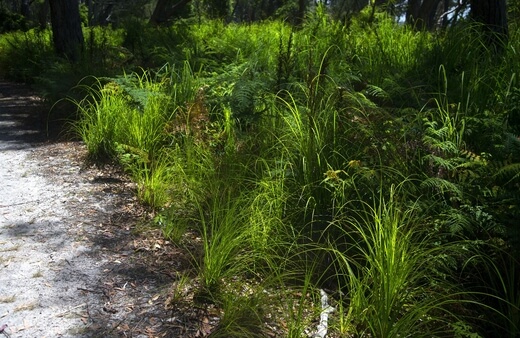
Lomandra is perhaps one of our most versatile and extensive genera of Australian native grasses. Generally sporting shiny and firm light-green leaves with a relaxed, arching habit, these grasses are available in many shapes, sizes and colour variations.
They perform their best in well-drained soils with full sun to partial shade daily. Prune every 3 years or so to keep Lomandra looking neat.
Popular varieties include:
- Lomandra confertifolia ‘Little Co’
- Lomandra longifolia
- Lomandra longifolia ‘Tanika’
- Lomandra ‘Lime Tuff’
- Lomandra longifolia ‘Katrinus’
- Lomandra confertifolia ‘Seascape’
See our Lomandra growing guide here for more detailed information.
21. Orthrosanthus multiflorus ‘Morning Iris’
This native grass species features gorgeous strappy lime-green leaves and masses of dainty blue star-shaped flowers in spring. With an ideal clumping form for gap filling, mass plantings or understory plantings, this species will normally reach 1 metre tall and wide.
It does prefer part shade but can tolerate full sun in cooler climates.
22. Branching Grass Flag – Libertia paniculata

Source: Growing Illawarra Natives
This tropical grass species is a great pick for those who have more shaded garden environments. It is a low-growing grass with an upright habit and a soft texture, making it a good lawn substitute as well.
It features glossy green leaves and petite star-shaped white flowers from spring to summer. These blooms contrast wonderfully with the green foliage beneath. Growth is only around half a metre tall and wide. Keep soil moist throughout the year and water supplementarily in long droughts.
23. Speargrass – Austrostipa scabra
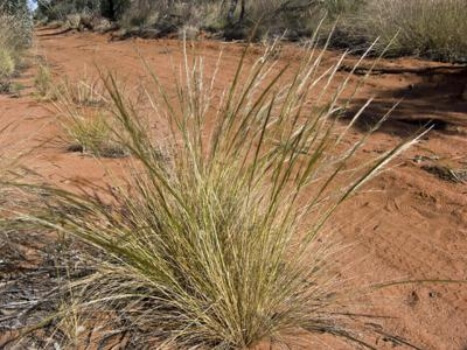
Source: keys.lucidcentral.org
This tough species of native grass can withstand poor conditions so it’s a good option for most Australian gardeners. It produces fine, strappy leaves with tall feathery seedheads.
Its upright form and dense habit makes this grass suitable for many positions within home gardens. It can tolerate drought and can also grow in areas with high temperatures and shallow soils. The foliage will reach between 10 and 30 centimetres tall and wide.
24. Snow Grass – Poa sieberiana
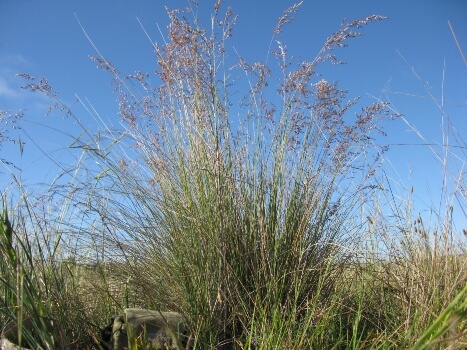
Source: Wikipedia
Also known as grey tussock grass, this native species is extremely hardy and will grow in almost any area of the country. It sports slender, soft green leaves that grow with a very fine habit. The seedheads are tall and willowy, offering a gorgeous texture to outdoor spaces.
In cultivation, it will reach 1 metre tall and wide. Full sun or part shade is preferred and well-draining soils are a must.
Quick Tips for Growing Australian Native Grasses
- Plant alongside other native flowers, plants and herbs for the best native aesthetics.
- Always select grasses that suit your specific soil types and light levels.
- For added contrast and texture, consider establishing several types of grass together.
- Use a combination of short and tall grasses for larger spaces.
- Plant early and late flowering grasses for longer-lived beauty in your garden.
- Use smaller growing varieties for border edging and larger growing varieties for gap-filling or features.
Should you also be interested in establishing a native hedge in your landscape, be sure to have a look at our extensive guide below for more helpful gardening information:
Australian Native Grasses Frequently Asked Questions
How many native grasses are there in Australia?
There are around 1,000 native grass species in Australia, all of which are highly adapted to our endemic conditions and they all play a vital role in maintaining our diverse ecosystems.
How do you care for Australian native grasses?
Most of our native grass species don’t require much care, especially once established. These grasses are usually very low-maintenance additions to the garden where basic care like trimming and watering should allow them to thrive.
How do you plant Australian native grasses?
Thanks to their hardy and adaptable natures, native grasses can be planted simply by digging out your planting hole, gently removing the young plant from its container and placing it into the hole, backfilling with soil once done then lightly watering.
Can Australian native grasses be used for a lawn?
Many species make for excellent lawn alternatives. Locality, climate, soil and site conditions are important considerations when selecting the best species for your landscaping needs but generally, our native grasses have become very popular ground cover and lawn substitutes around the country.
Weeping, Wallaby and Buffalo grasses tend to be preferred for lawns.
How do you trim Australian native grasses?
Over time, your ornamental native grasses can start to look a little unkept and untidy, usually crowding out their allocated sites. This is when trimming will be necessary.
Regular trimming or sometimes the occasional hard prune can keep them looking their best and rejuvenate them for the upcoming season. Be sure to also remove any dead thatch when pruning.
Should native grass be mowed?
Some species or growing conditions will benefit from mowing rather than trimming. As a general rule, most hill country native grasses should be moved about once per year.
Others can be mowed occasionally to maintain tidiness, especially when used as a lawn alternative.
How long does it take for native grasses to grow?
In warmer months, a newly sown lawn or gardening site can take between 1 to 3 months to fully establish. In cooler conditions, this can take around 3 to 4 months. These times will vary depending on the species and existing growing conditions.
How long do Australian native grasses last?
Most species tend to be perennials, living for 2 or more years on average. Annual grasses will only live for a single growing season. However, most of our natives self-seed rapidly and can be relied on to regrow and spread if desired.
Wrapping Up Our Australian Native Grasses Guide
So, there you have it, 24 fantastic ornamental Australian native grasses to choose from that can quickly add lovely colour and texture to your outdoor spaces while being easy to grow and care for.
Regardless of what your specific landscaping needs are, I believe you’re bound to find a few excellent species on this list that can elevate the native beauty and spectacle of your garden.
Be sure to chat with your local professionals to see what Australian native grasses are available in your area or look online as many vendors sell healthy seeds that can easily be established in your desired position.
Published on December 23, 2022 by Gary Clarke
Last Updated on September 19, 2024

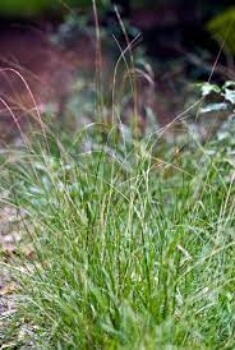
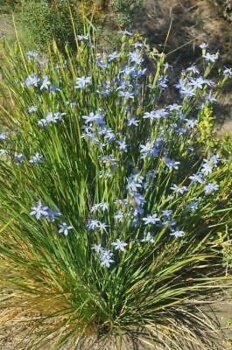




Good morning.. I would like to seek your advice. We have just developed an 800 sq mt native garden with 8 raised garden beds in Goondiwindi, southern QLD. In keeping with the native outlook, I would like to have Australian grasses rather than kikuyu between the beds. The area has been laid out with pop up sprinklers, using river water.
Having looked at your selection of recommended species, is it possible to obtain a mixture of seeds to sow in September or there about? The species i quite like are: Fountain Grass (Pennisetum alopecuroides), Pen alop ‘pinstripe’, Brush wiregrass, White Top grass, Poa labillardiera, Spear grass, and Snow grass.
We have some other grass growing in the beds: Barb wire grass, Purple Fountain grass, Poa, Cousin It, and several Dianella around the edge of a dry creek bed.
I hope you can give some advice.
Hi Ian,
Firstly, congratulations on your newly developed garden, I’m sure you guys are very excited to get things planted and start filling out the spaces with some beautiful native greenery.
By the sounds of things, native grasses will work perfectly between your beds and having existing irrigation set up is fantastic.
So, it’s hard to say precisely where you would be able to get an exact seed mix like the one you want. However, I’ve taken the liberty of finding a few excellent local websites that specialise in supplying Australian native grass seeds. Many of these companies do also allow you to place custom seed mix orders which is ideal for your landscaping needs.
Below I’ve listed a few of the top suppliers, many of whom are Queensland based as well. But they do all cater for nationwide delivery.
I’ve also added hyperlinks to their native grass seed pages below so all you have to do is click on them and browse their selections.
I hope someone can supply the seeds you want, there are contact details on all the sites for any enquiries.
·Williams Seed – New South Wales
·D&H Seed Harvest Co – Tasmania
·Queensland Native Seeds
·McKays Grass Seeds – Available seeds in Queensland and surrounds
·Native Seeds – Victoria
·Seed World Australia – New South Wales
Wishing you all the best with your new gardening ventures! Team AGT.